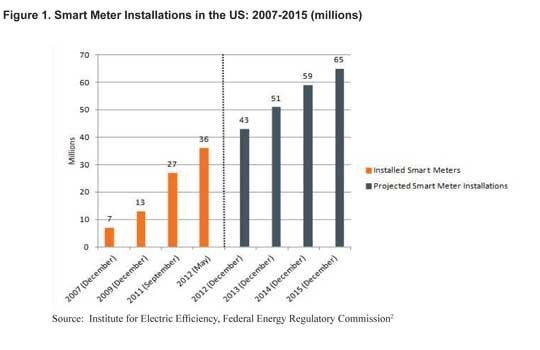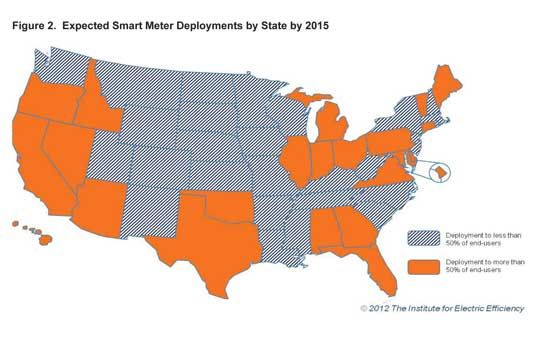Large smart meter installations may be slowing in the U.S., but as stimulus funds are spent, the overall number of meters is steadily climbing.
Nearly one in every three households in the U.S. has a smart meter, up from about one in four in September 2011, according to a new report from the Institute for Electric Efficiency, an organization that serves electric utilities. The current figure of 36 million smart meters will nearly double by 2015.

The figures from IEE do not include automatic meter reading installations, although the figures for 2015 include many large deployments that are still contingent upon commission approval for the final rollout. In many states, it’s not clear what the smart meter means for the average consumer, but that could be changing with the Green Button initiative, a voluntary industry effort that was started by the White House to promote people having access to their own electricity usage from smart meters.
The map of smart meter deployment shows clusters of states that have rolled out meters to at least 50 percent of customers. The largest gap is in the center of the country, where relatively low electricity prices make the business case for smart meters not as strong as it is in some other places.

However, in the Northeast, which has some of the highest electricity prices in the U.S., smart meter penetration is also relatively low, with New York, New Jersey and Massachusetts utilities not having any large-scale smart metering plans at this time.
Consolidated Edison, which covers most of New York City and Westchester County, probably will not re-file a business case for at least a few years for smart meters, according to one ConEd executive, because the state’s public utility commission is concerned about keeping current rates from rising, which they likely would if ConEd did a full territory deployment of smart meters at this time.
Connecticut Light & Power also had a proposal for more than one million smart meters, but the request has been suspended until the state legislature takes up the issue of meters.
There will be 24 utilities by the end of 2012 that have completed system-wide deployments of smart meters, including California’s three largest investor-owned utilities.
It is still early days for customers, utilities and third parties to creatively leverage the data coming off of the meters, but it is coming. Besides the Green Button initiative, telecoms and other consumer-facing companies, like WeatherBug, are looking to leverage the data to create attractive home controls offerings to customers.
The offerings from third parties may be key to smooth smart meter rollouts for the dozens of utilities putting in meters in the next few years. Nearly every state has seen some form of opposition, and many states have implemented opt-out rules for those who don’t want a digital smart meter.
Besides perceived health threats and privacy concerns, many utilities are selling the technology as something that will save people money. And some people might save some money when they have more insight into their energy use, but overall, utility rates will climb in coming years -- a message that seems too nuanced for most utilities to be able to communicate with the general public.
Overall, though, the chasm between utilities that are already committed to operational efficiencies and new product offerings via smart meters and those that are taking a wait-and-watch approach will likely only grow in coming years.
Tens of millions of meters that are being installed were helped along by stimulus funds, which have already been handed out. Utilities that want smart meters now are likely waiting for prices to continue to come down and to wait to watch the full implementations of the utilities that are doing it now before making a move. Dominion Power, for instance, is awaiting findings from its demonstration project before getting approval for 2.4 million smart meters.
The move from nearly 50 percent of U.S. households having smart meters in 2015 to 100 percent will be far slower than the first 50 percent. But if utilities, or other companies, can show real value associated with the technology in coming years, the business case will change for everyone.



